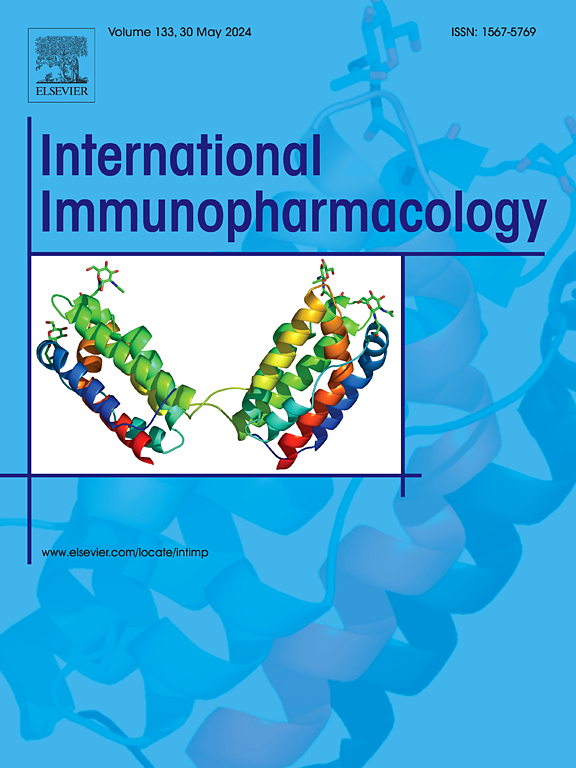Nature's answer to Ferroptosis: how bioactive compounds rewire oxidative stress circuits in cerebral ischemia
IF 4.7
2区 医学
Q2 IMMUNOLOGY
引用次数: 0
Abstract
Ischemic stroke is a cerebrovascular disease caused by the interruption of local blood flow in the brain. The mechanism of cerebral ischemia-reperfusion injury (CIRI) is complex and involves multiple pathological processes and signaling pathways. Ferroptosis, an iron-dependent regulated cell death form caused by excessive lipid peroxidation, is associated with the pathological occurrence and therapeutic response of various types of neurodegenerative diseases. Increased iron accumulation, free radical production, fatty acid supply, and lipid peroxidation are key factors in inducing ferroptosis. After acute ischemic stroke, the body experiences an over-accumulation of iron, lipid peroxidation, and reactive oxygen species in the cytoplasm by affecting neural system iron metabolism, lipid metabolism, and amino acid metabolism. This leads to the induction of ferroptosis. This article reviews the three metabolic pathways (iron metabolism pathway, amino acid metabolism pathway, lipid metabolism pathway, (seleno)thiol metabolism pathway, citric acid pathway, etc.) and multiple related regulatory signaling pathways (Nrf2 pathway; (hemi)cysteine/GSH/GPX4 pathway, NAD(P)H/FSP1/CoQ10 pathway; GCH1/BH4/DHFR signaling pathway; etc.) involved in ferroptosis occurrence in neural cells following acute ischemic stroke. It also highlights the changes in several key regulatory molecules, such as hypoxia-inducible factor-1α (HIF-1α), BTB and CNC homology 1 (BACH1), tumor suppressor gene p53, nuclear receptor coactivator 4 (NCOA4), and activating transcription factor 3 (ATF3), and the downstream mechanisms regulated by these molecules. Through an analysis of the potential mechanisms of ferroptosis occurrence and development in ischemic stroke, this article aims to provide reference for effective treatment of ischemic stroke and improvement of patient prognosis. Meanwhile, this review proposes a synergistic model of the “ferroptosis–oxidative stress–neuroinflammation” triad in ischemic stroke for the first time, providing a theoretical foundation for the development of neuroprotective agents based on natural compounds.
自然界对铁下垂的回答:生物活性化合物如何在脑缺血中重新连接氧化应激回路
缺血性中风是一种由局部脑血流中断引起的脑血管疾病。脑缺血再灌注损伤(CIRI)发生机制复杂,涉及多个病理过程和信号通路。铁下垂是一种由过度脂质过氧化引起的铁依赖性调节细胞死亡形式,与各种类型神经退行性疾病的病理发生和治疗反应有关。铁积累增加、自由基产生、脂肪酸供应和脂质过氧化是诱发铁下垂的关键因素。急性缺血性中风后,机体通过影响神经系统铁代谢、脂质代谢和氨基酸代谢,在细胞质中过度积累铁、脂质过氧化和活性氧。这导致铁下垂的诱导。本文综述了三种代谢途径(铁代谢途径、氨基酸代谢途径、脂质代谢途径、(硒)硫醇代谢途径、柠檬酸途径等)和多种相关调控信号通路(Nrf2途径;(半)半胱氨酸/GSH/GPX4通路,NAD(P)H/FSP1/CoQ10通路;GCH1/BH4/DHFR信号通路;等)参与急性缺血性脑卒中后神经细胞铁下垂的发生。强调了缺氧诱导因子-1α (HIF-1α)、BTB和CNC同源物1 (BACH1)、肿瘤抑制基因p53、核受体共激活因子4 (NCOA4)、活化转录因子3 (ATF3)等几个关键调控分子的变化及其调控的下游机制。本文旨在通过分析缺血性脑卒中中铁下垂发生发展的潜在机制,为有效治疗缺血性脑卒中,改善患者预后提供参考。同时,本文首次提出了缺血性卒中中“铁-氧化-神经炎症”三联机制的协同模型,为开发基于天然化合物的神经保护剂提供理论基础。
本文章由计算机程序翻译,如有差异,请以英文原文为准。
求助全文
约1分钟内获得全文
求助全文
来源期刊
CiteScore
8.40
自引率
3.60%
发文量
935
审稿时长
53 days
期刊介绍:
International Immunopharmacology is the primary vehicle for the publication of original research papers pertinent to the overlapping areas of immunology, pharmacology, cytokine biology, immunotherapy, immunopathology and immunotoxicology. Review articles that encompass these subjects are also welcome.
The subject material appropriate for submission includes:
• Clinical studies employing immunotherapy of any type including the use of: bacterial and chemical agents; thymic hormones, interferon, lymphokines, etc., in transplantation and diseases such as cancer, immunodeficiency, chronic infection and allergic, inflammatory or autoimmune disorders.
• Studies on the mechanisms of action of these agents for specific parameters of immune competence as well as the overall clinical state.
• Pre-clinical animal studies and in vitro studies on mechanisms of action with immunopotentiators, immunomodulators, immunoadjuvants and other pharmacological agents active on cells participating in immune or allergic responses.
• Pharmacological compounds, microbial products and toxicological agents that affect the lymphoid system, and their mechanisms of action.
• Agents that activate genes or modify transcription and translation within the immune response.
• Substances activated, generated, or released through immunologic or related pathways that are pharmacologically active.
• Production, function and regulation of cytokines and their receptors.
• Classical pharmacological studies on the effects of chemokines and bioactive factors released during immunological reactions.

 求助内容:
求助内容: 应助结果提醒方式:
应助结果提醒方式:


